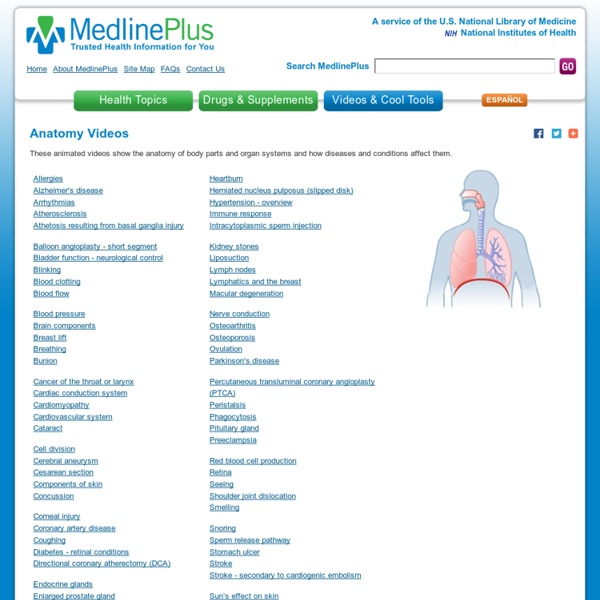Anatomy Videos
<span>To use the sharing features on this page, please enable JavaScript.</span> These animated videos show the anatomy of body parts and organ systems and how diseases and conditions affect them. The videos play in QuickTime format. The information provided herein should not be used during any medical emergency or for the diagnosis or treatment of any medical condition.
Anatomy and Physiology Learning Modules - CEHD - U of M
Quiz Bowl and Timed Test were retired at the end of summer 2013. Quiz Bowl had always been buggy, as many people had pointed out, and it had become difficult to maintain. It also used technology that doesn’t work on a lot of newer computers or tablets. Timed test depended on a browser add-on that both Microsoft and Apple have encouraged users to remove for security concerns. For these reasons, we took these two quizzes down at the end of the month. Thanks to everyone who has shown support for them, and we hope you continue to use the other quizzes on this site! Looking for the Image Bank? Conference for High School Anatomy and Physiology Instructors - October 17 and 18, 2014 - Minneapolis, MN.
11 Free Tools to Teach Human Anatomy in 3D
The following are some good resources to help students explore the human body through interactive imaging, games, exercises and more. Build-a Body: This is a great website that allows students to build the human body using interactive elements system by system. Each system has descriptions and provides some facts about diseases. Students will only drag and drop the parts of body such as bones, organs,..ect. BioDigital Human This is a great resource for anatomy. It lets users view the human body in 3D, hide or remove layers, create custom views and many more. Medical Animations The university of Pennsylvania Health System has a great website offering medical animations, explanations of several medical problems, resources on anatomy, physiology, and the human body. InnerBody This is a website where students can learn about human anatomy and physiology. Zygote Body This is the the substitute of Google Body. Visible Body This one here allows you to view the human body in 3D.
Anatomy and Physiology animations
Listed below are a collection of physiology animations and anatomy animations. These animations are intended to support text or lecture and it is important that they are not seen as stand-alone reference material. Notes: If you or your students discover any factual errors in the animations please let me know: andrew@visualization.org.uk Some of the animations can only be accessed from the university network - please contact Liz Hodgson in the LDU if you would like them on WebCT so that students can access them externally. Visual detail in Flash animations can often be magnified (click on the animation with the right mouse button and use the zoom control) Here are some animations of organs/organ systems: Cranial nerves (No text version) Cranial nerves (Customised version)) Anatomical directions and sections. Central and Peripheral Nervous System Vertebrae: meninges etc. Brain: meninges cerebrospinal fluid etc. Primary motor and somatosensory Cortices (Homunculus) Skin turgor Stomach, liver etc.
Brain Atlas - Introduction
The central nervous system (CNS) consists of the brain and the spinal cord, immersed in the cerebrospinal fluid (CSF). Weighing about 3 pounds (1.4 kilograms), the brain consists of three main structures: the cerebrum, the cerebellum and the brainstem. Cerebrum - divided into two hemispheres (left and right), each consists of four lobes (frontal, parietal, occipital and temporal). The outer layer of the brain is known as the cerebral cortex or the ‘grey matter’. It covers the nuclei deep within the cerebral hemisphere e.g. the basal ganglia; the structure called the thalamus, and the ‘white matter’, which consists mostly of myelinated axons. – closely packed neuron cell bodies form the grey matter of the brain. Cerebellum – responsible for psychomotor function, the cerebellum co-ordinates sensory input from the inner ear and the muscles to provide accurate control of position and movement. Basal Ganglia Thalamus and Hypothalamus Ventricles Limbic System Reticular Activating System Neurons Glia
Master Muscle List Home Page
Related:
Related:



